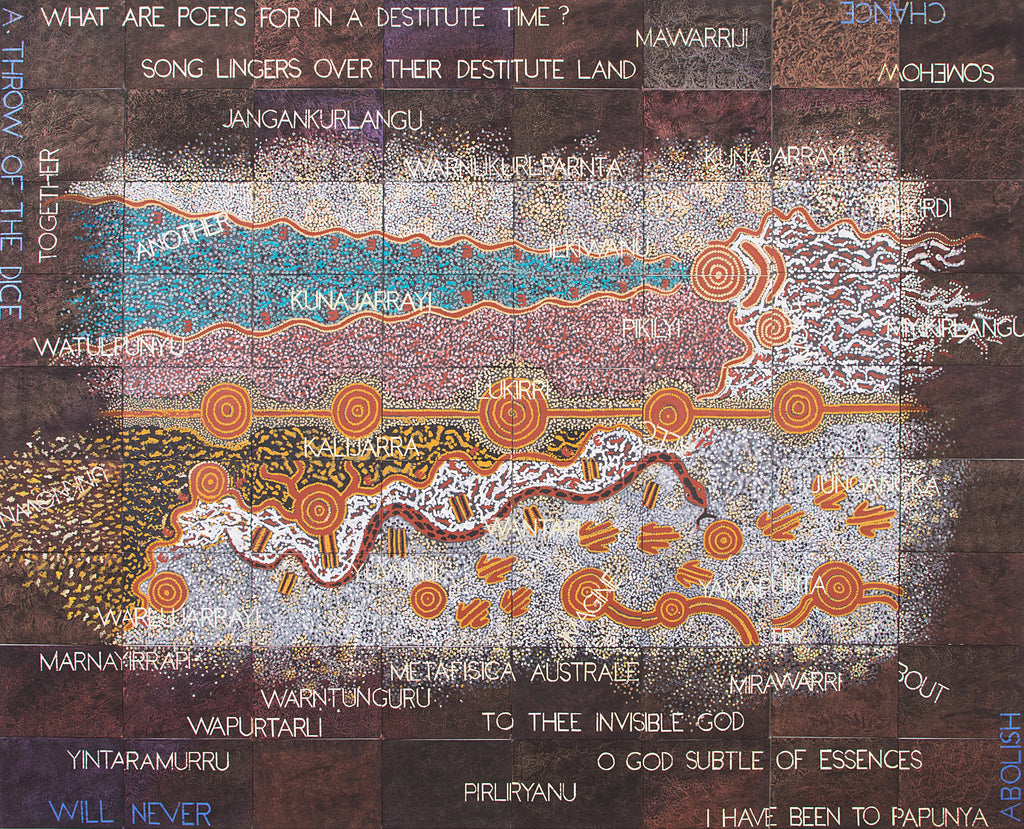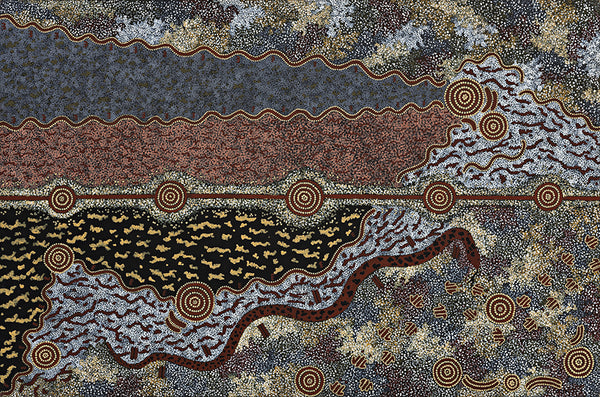Michael Nelson Jagamara AM, a Warlpiri man, is a pivotal figure in the evolution of Aboriginal Art

Michael Nelson Jagamara AM, 1988 - Antonin Cermak
Born at Vaughan Springs, about 100 km west of Yuendumu (NT), his father, an important Warlpiri Medicine Man, instilled in him a deep connection to his culture and heritage. Jagamara's early encounters with white men were marked by fear, as he recalls hiding from them in the bush.
As a boy, Jagamara moved to Yuendumu to receive a European education at the mission school. However, after his initiation at thirteen, he embarked on a diverse path, working as a cattleman and joining the army. He eventually returned to his country, settling in Papunya in 1976, where he married and worked in the government store.
Jagamara's artistic journey began in earnest in 1983 when he joined Papunya Artists as a full-time member. Although he was not the first artist to start painting at Papunya, he quickly became one of its most well-known figures. In 1984, he was awarded the first National Aboriginal Art Award (now the Telstra NATSIAAs) for his work 'Three Ceremonies' (1984), marking the start of a meteoric rise in his career.

Metafisica Australe, 2017, Imants Tillers and Michael Nelson Jagamarra
His collaboration with Australian artist Imants Tillers in 1985 on the work 'The Nine Shots' (1985), exhibited in the 6th Biennale of Sydney, was a significant moment in his career, reflecting a postmodern gesture and a transgressive approach to art. This collaboration continued over the years, resulting in 24 paintings exchanged between Papunya and Cooma, NSW, where Tillers resides.
Michael Jagamara Nelson’s painting Five Stories of 1984 is one of the iconic images of modern Aboriginal art. It has been published and exhibited widely, possibly more so than any other work by an Indigenous Australian artist. During the 1980s and 1990s Five Stories featured in several landmark exhibitions in Australia and abroad at a time when Aboriginal artists were breaking through the barriers that had consigned their art to the ethnographic domain to emerge as part of the discourse that is the world of contemporary art. Five Stories was among three works by Jagamara selected for the 1986 Biennale of Sydney, origins, originality + beyond. This was the first time Aboriginal artists were represented in the Biennale. It featured on the cover of the seminal exhibition Dreamings: The Art of Aboriginal Australia organised by the South Australian Museum and shown at the Asia Society Galleries in New York in 1988. The high profile of this exhibition introduced a new set of international collectors to Aboriginal art and initiated a debate as to its place in the continuum of contemporary art worldwide. Similarly, the exhibition Crossroads–Towards a new reality mounted at the Museums of Modern Art in Tokyo and Kyoto in 1992 established a place for modern Aboriginal art in Japan. Five Stories was one of the key works in the highly acclaimed exhibition Aratjara: Art of the first Australians, that opened at the Kunstsammlung Nordrhein-Westfalen, Cologne, and toured to the Louisiana Museum in Humlebaek, Denmark, and the Hayward Gallery in London in 1993-94; the exhibition introduced western Europe to contemporary developments in Aboriginal art. In 2000, the painting featured in Papunya Tula: Genesis and Genius, a watershed exhibition that traced the evolution of the acrylic painting movement that had originated at the settlement of Papunya in 1971: the exhibition was staged at the Art Gallery of New South Wales in Sydney during the Olympic Games. Five Stories was shown again in Europe in Desert Art at the AAMU Museum of Contemporary Aboriginal Art in Utrecht, the Netherlands, in 2002.
Wally Caruana - Excerpts from catalogue essay Sothebys Aboriginal Art London 21 September 2016

Five Stories, Michael Jagamara Nelson, 1984
At the Sotheby's London auction, Michael Nelson Jagamara's iconic work, Five Stories, 1984, achieved an artist record, and perhaps also a record for the highest price for any living Aboriginal artist, when the work sold for AUD$687,877 (GBP401,000), more than doubling the pre-sale estimate of AUD$256,500-$342,000 (GBP150,000-200,000). The work, offered to auction from the Gabrielle Pizzi Collection, is considered to be the most significant piece of contemporary Aboriginal Art, and is said to be the most published and exhibited work by any Indigenous Australian artist.
His contributions to public art include a mural for the Sydney Opera House and a major mosaic work for the forecourt of Parliament House in Canberra, titled 'Possum and Wallaby Dreaming', which was unveiled in 1988 in the presence of the Queen.
His painting style evolved from meticulous rendering to a more simplified, expressionistic, and calligraphic approach in the 2000s. Despite facing challenges in the mid-1990s, his collaboration with Brisbane's Campfire Group and his relationship with dealer Michael Eather reignited his practice.
Jagamara's leadership extended beyond his art, as he served as president of the Papunya Community Council and was a founding artist leader at the new Papunya Tjupi art centre. His contributions to Aboriginal art were recognised with an Order of Australia Medal in 1993 and a Fellowship from the Visual Arts Board of the Australia Council in 1994.
Michael Nelson Jagamara's legacy is profound, encompassing a blend of traditional Warlpiri motifs and contemporary artistic expression. His work continues to inspire and challenge, offering a window into the rich cultural tapestry of Aboriginal Australia and the ongoing dialogue between tradition and modernity.
